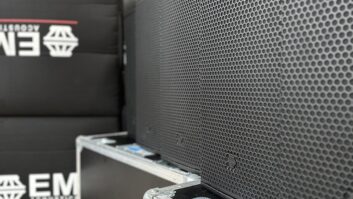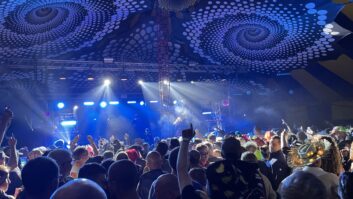
For a world-class stadium, a high-performance communications network is a must. Phil Ward reports.
The progress of fibre-optic networks now seems embedded in the progress of German fibre-optic distribution pioneer Optocore. Its strategic partnerships latterly included Clear-Com, a company with its own mission to connect the globe via comms systems. The first fruits of this labour were the V3R-FX-Intercom, a 4-channel unit, and the 8-channel X6R-FX 8, both of them Clear-Com devices based on Optocore’s X6R and V3R signal converter platforms. As a result, Clear-Com Eclipse matrix systems, 4-wires and intercom control panels enter the fibre-optic world and stadiums, in particular, stand to benefit from the union.
Juan Montoya, of Bosch Sistemas de Seguridad, Central Latin America, outlines the case for advanced DSP. “The size of world-class stadiums means that traditional audio cabling is inefficient,” he says. “For this kind of project you need something like Bosch’s OMNEO media networking architecture: transport of audio and control in one single cable using TCP/IP infrastructure.”
“Dual redundant AES67 networking ensures compatibility with standard IT infrastructure,” adds Barbour, “so the audio system can leverage the site-wide, converged network that facilitates all other networked components in the venue. Our Q-Sys Core processors provide complete, automated processing redundancy allowing virtually zero downtime. Critical I/O can be connected to dual redundant I/O devices, ensuring that important audio inputs and outputs are always available. GPIO on all of the networked I/O and Core processors ensures that integration with VA systems at any location in the building is simple, while network-connected and monitored paging stations allow distribution of paging capability throughout the stadium.
“Standards-based, networked audio and control integration with digital video distribution systems such as Cisco StadiumVision and SVSi ensures that the audio, video and control components in the venue are truly tied together in one networked, integrated package. Native AES67 support ensures compatibility with any Ravenna-, Telos- or Livewire-based broadcast system that should arrive for an event. Dante and CobraNet I/O cards enable the designer to breakout to third-party networking protocols at the edge, as required, for integration with touring and production audio systems.”
Dave Howden, director of technical services for Community Professional Loudspeakers, agrees that fully integrated audio across the main bowl, the ancillary zones and the broadcast infrastructure is now possible (see boxout above). “It’s also very desirable for commercial purposes,” he says, “and essential for life safety when a venue has to take responsibility for the security of large numbers of people. It’s also assumed that all sound systems will achieve the expected intelligibility, SPL and coverage.
“For all systems, interconnectivity by a reliable digital and redundant link to amplifier rooms is greatly desirable. Amplification is expected that provides continuous monitoring of key amplifier and speaker parameters back to the operator’s position. This is especially important for systems that fall under, or double as, life safety systems. They must be able to interface to the command centre, which may take control of AV systems if a situation warrants it.”
Zoning is another fundamental requirement. “The ability to zone off main seating areas is also desirable,” adds Howden. “If an upper deck is not in use there’s no need to damage intelligibility by introducing energy into those empty areas. This is also true for playing surfaces where you may want sound at some times, but not at others – the broadcasters will thank you for this!”
www.boschsecurity.com
www.clearcom.com
www.communitypro.com
www.optocore.com







